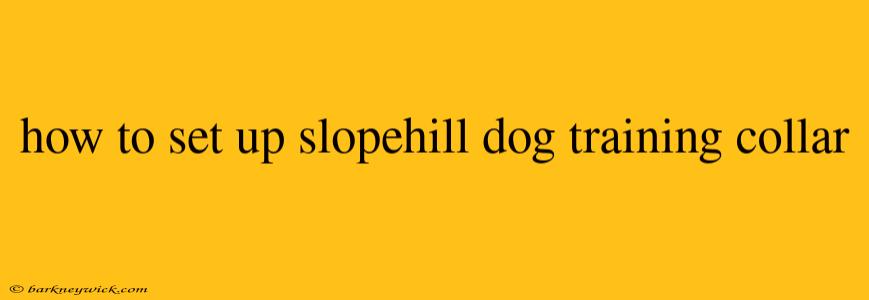Mastering the Slopehill Dog Training Collar: A Step-by-Step Guide
Have you ever felt frustrated trying to train your dog? I know I have! My rambunctious Golden Retriever, Buddy, was a handful. He'd pull on the leash, ignore commands, and generally make a mess of our walks. Then, I discovered the Slopehill Dog Training Collar.
It was a game-changer. This innovative collar helped me regain control and create a positive, enjoyable experience for both of us.
Here's a breakdown of how to set up and use a Slopehill Dog Training Collar, based on my personal experience and research:
Getting Started:
- Choosing the Right Size: Slopehill offers collars in different sizes to accommodate various breeds and dog sizes. Consult their size chart to ensure you select the perfect fit for your furry friend. It's essential that the collar sits comfortably and securely around your dog's neck, without being too loose or too tight.
- Understanding the Components: The Slopehill collar is made up of a few key elements:
- Receiver: This is the part that goes around your dog's neck. It's water-resistant, so you don't have to worry about rain or puddles.
- Remote: This handheld device sends signals to the receiver and allows you to control different functions like vibration, tone, and stimulation levels.
- Charging Cable: The receiver and remote both require charging for optimal performance.
Setting Up Your Slopehill Collar:
- Charge the Receiver and Remote: Before first use, make sure both the receiver and the remote are fully charged. This will ensure smooth operation and prevent any issues with battery life.
- Attach the Receiver: Securely attach the receiver to your dog's collar. The receiver should sit snugly and comfortably on their neck.
- Pairing the Remote: Most Slopehill collars require pairing the remote with the receiver. Refer to the user manual for specific instructions on how to do this, as it may vary between different models.
- Adjust Stimulation Levels: The Slopehill collar allows you to adjust the stimulation levels based on your dog's sensitivity. Always start with the lowest setting and gradually increase it if necessary. It's crucial to watch your dog's reaction closely and never use a level that causes them distress or pain.
Training with the Slopehill Collar:
- Positive Reinforcement: While the Slopehill collar provides a helpful tool for training, it's essential to incorporate positive reinforcement techniques. Praise, rewards, and a happy, encouraging demeanor work wonders!
- Consistency is Key: Train your dog in short, consistent sessions. Don't overwhelm them with too much information or too many commands at once.
- Start Simple: Begin with basic commands like "sit", "stay", and "come." As your dog progresses, gradually introduce more advanced commands.
- Professional Guidance: Consider seeking guidance from a certified dog trainer to ensure you're using the Slopehill collar correctly and effectively.
Important Considerations:
- Safety First: Never use the Slopehill collar as a punishment tool. Its purpose is to provide gentle, safe corrections that help your dog learn desired behaviors.
- Check for Skin Irritations: It's important to check your dog's skin regularly for any signs of irritation, redness, or discomfort. If you notice any issues, discontinue use of the collar and consult with a veterinarian.
- Responsible Use: The Slopehill Dog Training Collar is a valuable tool for training, but it should be used responsibly and with proper guidance.
Conclusion:
The Slopehill Dog Training Collar has been a game-changer for me and Buddy. With its help, we've learned to communicate better and enjoy our walks together more than ever before. However, it's essential to use it responsibly, prioritizing safety and positive reinforcement. Remember, training is a journey, not a race!
By following these tips and incorporating patience, consistency, and positive reinforcement, you can use the Slopehill collar to successfully train your dog and strengthen your bond.
